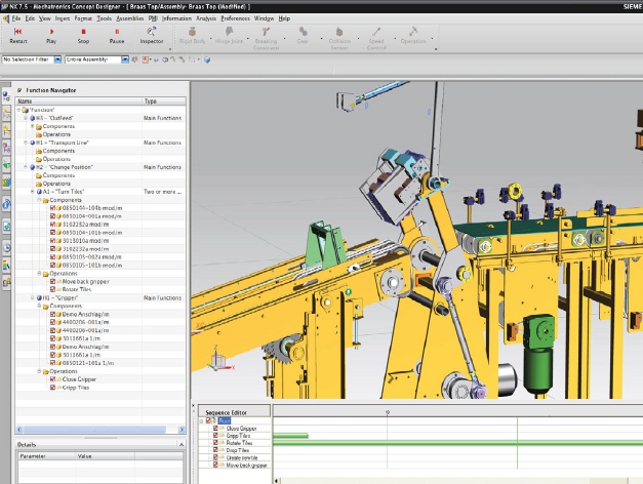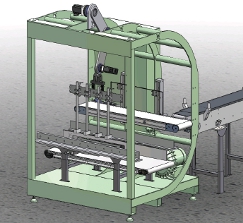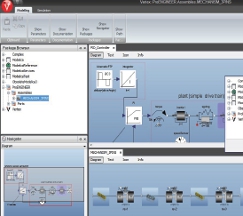Systems technologies and mechatronics are receiving increasing interest from users and vendors alike. Allan Behrens has been tracking this growing segment which he believes we will soon be hearing a great deal more about
From recent discussions with software authors, many are gearing themselves up to their next generation of products, focused on better automating the process of engineering and manufacturing.

Mechatronics Concept Designer from Siemens PLM software will make it easier for companies in the machinery space to develop, engineer and virtually prototype machinery with elements such as embedded controllers, actuators and sensors
It’s easy to get hung up, as many do, on technology for technology’s sake – better mousetraps for want of a better phrase. But what really matters to customers is often a change in the application of technology, not the technology itself.
Making products that encompass elements of machinery, electronics, software, hydraulic and control systems has always been challenging. On one hand, many organisations have politic, inter-disciplinary collaboration and developmental workfl ow issues that create signifi cant barriers to innovation and business improvement.
On the other, the tools that are often used in the various disciplines (mechanical, hydraulic, pneumatic, electrical control, electronic and software etc.) exist or are used in isolation.
The bottom line is that while many of us understand the values of closer collaboration, shared data and integrated workflows, practically this has been something of a lofty goal
AdvertisementAdvertisement
Information that’s created and reused within the discreet (often parallel) workfl ows is managed in varying systems, often to be brought together at the machine build stage, usually at a late stage in the product’s development lifecycle.
I hasten to add that these challenges aren’t just apparent in development (as we all know).
Autodesk, as an interesting side note, has a vision that extends to the practical realities of its customers; observing that allowing enterprise users to capitalise on new innovation in the design department without seismic disruption on the integration with lesser evolutionary solutions such as Enterprise Resource Planning (ERP) is a shrewd observation.
Breaking down barriers
The bottom line is that while many of us understand the values of closer collaboration, shared data and integrated workfl ows, practically this has been something of a lofty goal.
Unfortunately there is no single solution to this complex problem. Save getting embroiled in discussions about the way people and the groups within companies operate, it’s safe to say that there’s much happening,
specifically in larger companies to try and break down operational barriers between different disciplines.
The machine as ‘system’ is forcing companies to rethink their developmental workflows. In concert with this change a number of software companies are taking the opportunity to revisit practical solutions to multidisciplinary engineering.
I think it’s only fair to say at this stage, that the technology barriers to a completely integrated development solution are immense. For one thing the widely varying needs of the individual disciplines (ME, SW, EE etc.) create product paradoxes that are diffi cult to solve; importantly they’re exceptionally difficult to resolve in a single (software) company. Can any one company really do everything?
Notwithstanding the developmental challenges, many companies in the engineering space are working on practical (dare I say easier) solutions that play to the challenges above.
Siemens PLM Software, for example, with its recent launch of Mechatronics Concept Designer, delivers an innovative solution that’ll make it easier for companies in the machinery space to develop, engineer and virtually prototype machinery with elements such as embedded controllers, motors, actuators and more importantly sensors.
SolidWorks, with partners such as Rockwell and National Instruments have also made headway into the affray. Rockwell’s solution in particular focuses on complementing designers using their own range of products.
Although the Siemens product is at an early stage of its evolution, one can imagine future iterations extending its remit to manufacturing, production and test and indeed other vertical disciplines.
All systems go
Dassault Systèmes has made some interesting acquisitions in the recent past to fill out its portfolio of cross-domain applications.
It acquired Dymola a couple of years ago and more recently Geensoft, placing a significant stake in the ground in the complex mechatronics systems technology space, focused primarily on Automotive and Aerospace segments.
Both large and small alike appear to be rallying to the complex systems space. The likes of IBM with its Rational Brand have made it clear that it sees this as an area of significant interest. MSC Software has its Easy5 controls and systems simulation application and LMS (Belgium) has invested recently by adding US-based Emmeskay to its portfolio of systems technologies.
The company’s past solutions included the AMESim suite for 1D multidomain modelling and simulation.
As many will know Mathworks is also in this space as are a number of smaller (no less interesting companies) working on developments – of note ITI and MapleSoft.
One company yet to deliver product but nonetheless making waves in this space is DeltaTheta from the UK. Talking to its developers it appears that there are some interesting dimensions yet to be capitalised on in this market.
Future focus
The interest in systems and integration is driven by many factors. Not the least of these is a desire by companies such as those in the automotive segment to move beyond traditional cost cutting and differentiation programs of recent past.
Although systems technologies and mechatronics are of significant interest to many, the concept and application is yet to make the mainstream. I’m certain that we’ll hear more on the topic spurred no doubt by customer demand, the recent bout of acquisitions and innovative products from amongst the companies noted earlier.
I for one will continue to track this segment – small as it may be (at the moment). What I’m interested in is feedback from users, large and small alike, on their thoughts and desires – feel free to respond by email directly and let me know your thoughts.
If interest is forthcoming I’ll be delighted to follow up on these topics with more detailed analyses in areas that interest the readership.
Allan Behrens is managing director of industry analyst and consultancy firm Taxal. Often occupied on markets, technologies, sales channels and trivia he (sadly) considers himself to be somewhat of a learned authority on gadgets and gizmos.
{encode=”allan.behrens@taxal.com” title=”allan.behrens@taxal.com”}

Allan Behrens has been following this growing technology segment








